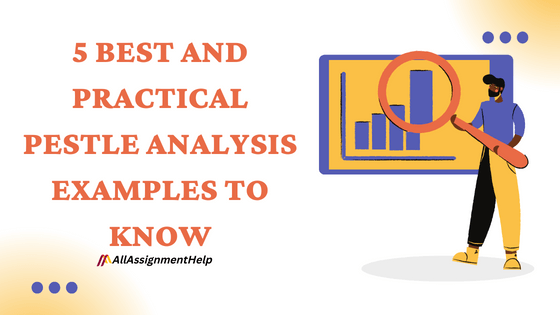Table of Contents
A PESTLE analysis studies the macrotrends in the business or organization’s immediate surroundings. It looks at the aspects of the operational market that might affect your business or organization favorably or negatively, including political, economic, social, technological, legal, and environmental aspects. PESTLE analysis is a part of Business Studies, Management, and Marketing. Therefore, students studying these subjects are often required to conduct a PESTLE analysis as part of their coursework. However, they fail to do it right as they are not completely aware of the analysis process. In this blog of All Assignment Help, we will present 5 best PESTLE analysis examples for students to enhance their understanding of the concept. You can leverage these examples to excel in your assignments at university.
How To Do PESTLE Analysis?
What is the real procedure for doing a PESTLE analysis? The good news is that the procedure for doing a PESTLE analysis is almost identical to that of conducting any type of competitive analysis or supporting strategic planning.
Here are the steps involved in the process:
Set objectives and goals
The first stage in any analysis is to be very clear about what you are looking for. Are you attempting to get a competitive edge? If so, the opportunities and risks presented by your competitive environment will catch your attention. PESTLE analysis could assist in finding them and show you how to take advantage of them. Don’t neglect the initial stage of defining your primary objectives, as it will guide the rest of your analysis.
Preparation
Although you can conduct PESTLE analysis in microcosm or brainstorming alone, you will achieve the best results if you include teams or individuals from all areas of the business. Additionally, if you’re working with a large number of individuals, you will need to respect their time by finding a technique to efficiently ask them all and gather their opinions.
Data collection
The PESTLE analysis case studies collection is a beneficial practice if you have the time. You will be able to predict future occurrences with the help of records of particular previous events and their effects on your organization. You should have everything set up by now, so all you need to do is ask questions, schedule meetings, and get the required information.
Data analyzation
Now that you have gathered your data, it is time to start the real analysis. It is first necessary to process all of your data to draw insightful conclusions. Most of the data you gather will probably be text-based, but hold on! All of the data processing doesn’t have to be done by you. Keep in mind that there are business and marketing assignment help experts available online to do the task for you. They are experts in this field and will do the right and accurate analysis of the given data.
Develop a strategy of action
Your conclusions on the possible effects of the data you have discovered for the business should serve as the foundation for your action strategy. Undoubtedly, this should also be in accordance with and influenced by the main goal of the analysis you stated at the very beginning. Moreover, determine what must be done and divide this into a number of manageable stages based on any firm findings you have made.
Execute and implement your strategic plan
You are aware of what has to be done. The only thing left to do is enter your steps into the project management software. In this way, everything is monitored. Each responsibility contains specifics and a designated owner. Create project boards with task dependencies as needed to provide visibility into any problems or obstacles.
A PESTLE analysis studies external market factors rather than the internal strengths and weaknesses of the business. The characteristics of the organization determine its strengths and limitations.
Read Here: PESTLE Analysis: A Significant Business Analysis Tool
5 Best PESTLE Analysis Examples
Below are the companies discussed in our PESTLE analysis examples:
- Uber
- Nike
- Coca-Cola
- Adidas
- Apple
1. Pestle Analysis Examples: Uber
Uber is a rapidly growing taxi service provider in the world. People like its features, such as easy accessibility with the app and taxi sharing. However, there are controversies such as minimum wage complications and banning that are not helping its cause.
And now let us find out more about this company through a PESTLE Analysis example. The infographic below will give you a brief on what we have discussed ahead:
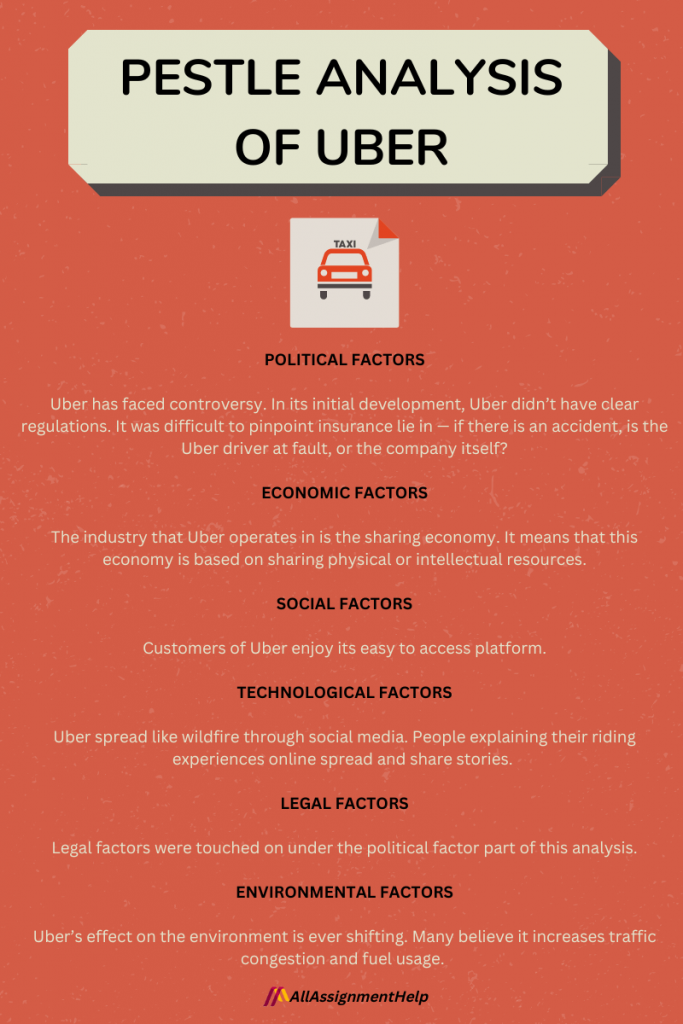
Political Factor: Endless Controversies
Uber has faced numerous controversies, many of which stem from a lack of clarity regarding its regulations. One significant issue is the ambiguity surrounding its insurance policies. Users often have pressing questions, such as:
- Accountability in Accidents: Will the company hold the driver accountable for incidents, or will Uber assume responsibility?
- Insurance Coverage: What exactly does Uber’s insurance policy cover during a ride?
- Regulatory Compliance: How does Uber ensure compliance with local laws and regulations in different markets?
- Driver Classification: Are drivers classified as independent contractors or employees, and what implications does this have for their rights and benefits?
This uncertainty not only undermines trust but also complicates the regulatory landscape in which Uber operates. Addressing these concerns transparently is crucial for Uber to navigate its political challenges effectively.
Read Here: PESTLE Analysis: A Significant Business Analysis Tool
Economic Factor: Sharing Economy
Uber operates within a sharing economy, where physical and intellectual resources are shared among users. This model allows customers to easily connect with drivers via the app, facilitating convenient transportation at generally lower costs compared to traditional taxis.
Key Economic Insights:
- Cost Advantage: Many customers find Uber more affordable than conventional taxi services, making it a popular choice for transportation.
- Rapid Growth: Since its inception, Uber has experienced remarkable growth, expanding its reach in numerous markets around the globe.
- Regulatory Challenges: In some regions, Uber faces accusations of unfair competition against regular taxis, leading to bans and restrictions on its services. This scrutiny is not limited to Uber alone; other ride-sharing companies are also being evaluated for similar issues. However, Uber remains the primary focus due to its market dominance.
- Job Market Impact: The rise of Uber has sparked debates about its effect on employment. While some view it as a threat to traditional jobs in the taxi industry, others see it as a source of new job opportunities for drivers seeking flexible work arrangements.
- Market Potential: Despite the challenges, Uber benefits from its strong brand recognition and the overall demand for taxi services. The transportation market presents ample growth opportunities, and Uber must continue to innovate and adapt to maintain its competitive edge.
Social Factor: Easy availability
- Uber taxi services are user-friendly and accessible.
- To book an Uber ride, all you need to do is order through a mobile app. In a few minutes, you will get the confirmation of your ride.
- People show gratitude to Uber for an affordable ride. It increased the fare charges with its popularity. However, people still prefer it due to its accessibility.
Technological Factor: WildFire
- Uber has reaped many benefits through the technology, directly and indirectly.
- People post positive views on various social media platforms. It has helped the company to grow fast. Next, its app is very helpful for users.
- Users can book their cabs from anywhere. App also gives information like estimated ride charges, drop-off location, traffic, and weather. Users can pay their charges through the app.
Legal Factors: Bannings
Above, we discussed how Uber has faced bans in many countries for different reasons. Hence, the company needs to follow technical usage laws, labor and employee safety laws, and copyright laws as well. However, you can know more about legal factors associated with uber under the guidance of an experienced law assignment help service provider.
Environmental Factors: Questionable responses
- The impact of Uber on the environment is not certain. Few say that fuel usage and traffic congestion is increasing.
- Studies say the same when it comes to traffic congestion. It is because people may use Uber instead of public transport. Analysts are yet to confirm such blame.
Conclusion
In conclusion, Uber is the fastest-growing taxi service provider. Its affordable charges and ease of use have helped it become popular. Some controversies are also hindering its progress.
However, the company must carry on its service throughout the world. Of course! They need to keep a check on the controversies as well.
2. Pestle Analysis Examples: Nike
Nike Corporation, a prominent US-based international company, specializes in the design, development, and sale of footwear, clothing, and various sports-related services. Renowned for its innovative sports shoes and apparel, Nike has established itself as the leading brand in the athletic wear industry. In 2015, the company generated an impressive revenue of $30.601 billion, solidifying its position as the most valuable brand in the sports sector.
Now, let’s conduct a PESTLE analysis of Nike to gain insights into its current standing and the external factors that influence its operations. The infographic below provides a concise overview of the key points we will explore.
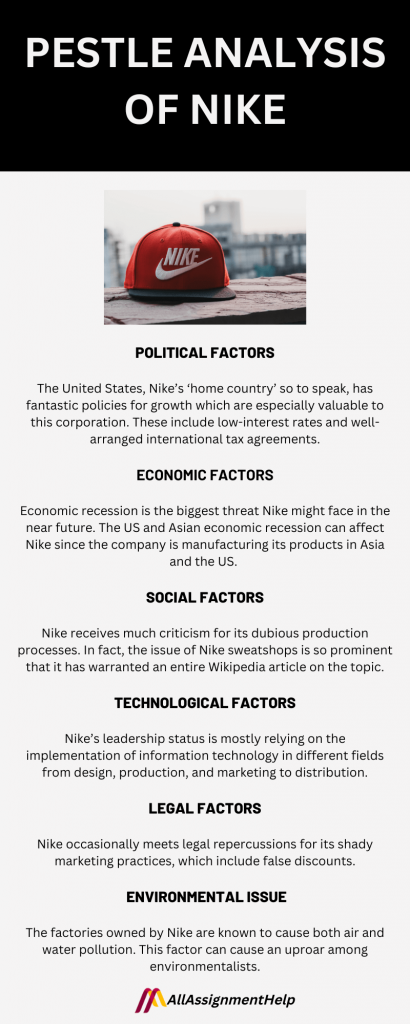
Political Factor: Must Consider Taxation
- The political environment has a huge impact on Nike as it is globally present. Hence, the company must consider the taxation and manufacturing rules of a country.
- Nike needs to keep an eye on the import and export laws of a country. It affects its product distribution worldwide.
Economic Factor: Must Have Good Purchasing Power
Nike needs to focus on the conditions of the economies where it offers its products.
- It can target economies such as US, UK, and others. All these countries have a stable economy. Nike can find customers with good purchasing power there.
- Fast-growing nations are also an opportunity for Nike.
Social Factor: Needs to Refine Their Production Practices
- Nowadays, people are conscious of their health. They are increasingly playing sports to stay fit. Nike plays an active role.
- It regularly comes up with high-quality sports shoes and apparel. It molds its products as per the customers’ needs to get positive results.
Technological Factor: Excellent Use of Social Media
- Nike gives importance to technology. It also needs to keep an eye on the technology it manufactures. It will help the company compete well in the market.
- R&D investment is the external technological factor that affects Nike. The constant changes the technology are an opportunity, and a threat as well.
Legal Factor: Affects Large Businesses Globally
- Nike should keep an eye on the copyright of the designs of shoes and apparel it manufactures.
- It also has to make sure it is not involved in child labor or breaking employment rules.
- Health and safety rules are also important for Nike to follow to maintain its global reach.
Environmental Factor: Products are Not Environmentally Friendly
- At present, the environment is the prime concern globally.
- Nike is a leading brand. The company needs to come up with environmentally friendly products. It will help them gain brand value.
- Also, it will increase sustainability for the company.
3. Pestle Analysis Examples: Coca Cola
Coca-Cola is a famous soft drink producer. It offers different products to its large number of customers worldwide and uses the finest technology in production. Moreover, its products meet customers’ expectations. If you are assigned a PESTLE analysis assignment on Coca-Cola, you can always go for online assignment help for well-researched and analysed content. This will help you impress your professor.
Let us take a look at the PESTLE analysis example of Coca-Cola. The infographic below will give you a brief on what we have discussed ahead:
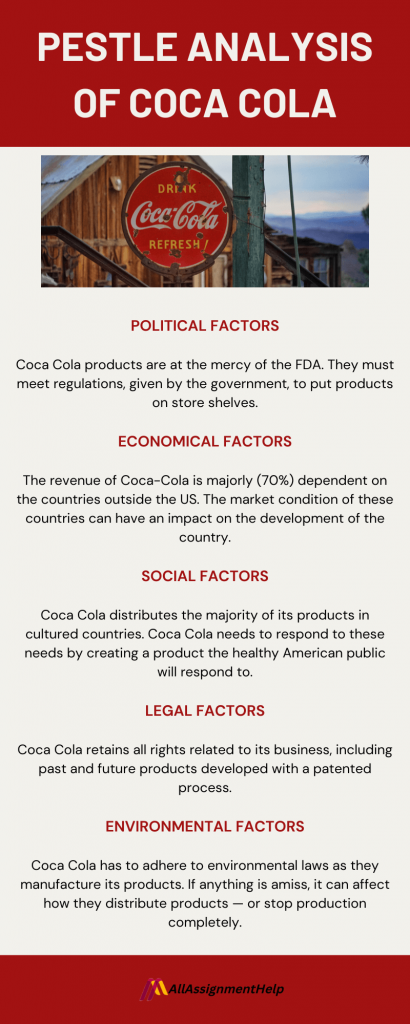
Political Factor: Must Follow FDA Rules
- Coca-Cola products are tested by the FDA. It should follow the rules of a country. It should also provide the local stores with the best beverages.
- Countries may prevent it from distributing its products if all the rules are not followed well.
- Rules can be related to accounting, internal marketing, labor, or taxes.
Economic Factor: Focus on Healthy Drinks
- Coca Cola has a huge customer base around the world. The company produces its products in various countries.
- It keeps its customers’ tastes and preferences in mind. Most of its revenue comes from beverage sales.
- Recently, people have started giving preference to healthy drinks. Coca Cola has realized it. It is moving in that direction.
Social Factor: Social Pressure in Middle Eastern Countries
- Urban areas are the major market for this company.
- Coca Cola has introduced more than 30 alternative flavors in Japan. It has done the same in China.
- It is more focused on offering healthy products when it comes to the US. Coca Cola water and teas are some of the products that come under this category.
- Coca Cola can take the same approach in countries such as Japan and China.
Technological Factor: Boon in Social Media
- Coca Cola can be very effective with the use of new technologies.
- It will help it in manufacturing a large number of quality products.
- Coca Cola has a technological setup in Britain. It ensures customers get the finest products in a short time.
- Coca Cola has also used social media to increase its popularity. Its promotion campaigns have been a hit on various social media platforms.
Legal Factor: Retains all Rights
- The company has done well in securing all the rights of its business. It has the rights to all the past and future products that it develops with a patented process.
Environmental Factor: Biggest Consumer of Fresh Water
- Water accessibility is essential for Coca Cola to manufacture its products. If they don’t have water accessibility, then they can’t operate.
- It needs to ensure that water processing is environment-friendly.
Conclusion
In conclusion, Coca Cola is a well-known brand around the world. It is famous for its soft drinks. However, it also needs to cover the customers who are keener on consuming healthy drinks.
Also Read: Strategic Analysis Tool
4. Pestle Analysis Examples: Adidas
Adidas is in sports shoes and apparel. It is a Germany-based firm and got its name inspired by its founder, Adolf Hassler. The company is still running well and tackling all the economic challenges of various economies.
Let us take a look at the PESTLE analysis example of Adidas to know the external factors that affect it. The infographic below will give you a brief on what we have discussed ahead:
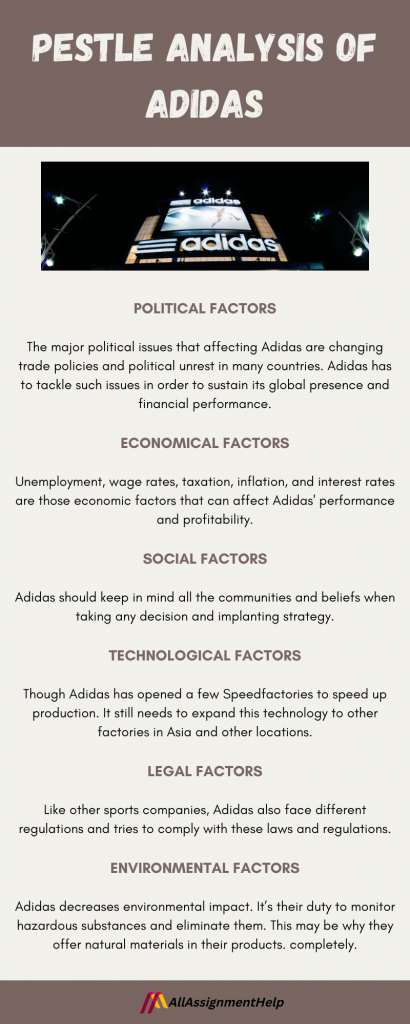
Political Factor: Many Systems
- Adidas is a company that has faced many risks and civil unrest. It dealt with huge changes in political policies.
- It has been in focus on various political factors. Some are war, terrorism, expropriation, and nationalization. All these factors cost money and time. It mostly delayed product delivery.
- The tax system is another factor that keeps changing based on the party.
Economic Factor: Credibility Problems
- Till 2005, this company faced many economic failures. Economic factors such as inflation, per-capita income, unemployment, and taxation affected its profits.
- Instability in the stock market also affected its growth rate.
- These factors also affect the purchasing power of the customers. It resulted in a decrease in the revenue of Adidas.
Social Factor: Consumer Awareness of Health
- Adidas shoes and apparel designs meet the latest trends and are distinctive. People of all ages, cultures, and religions use it.
- The company mostly attracts customers who are sporty and athletic. Social factors affect the purchasing habits of a person.
- The thing that Adidas needs to focus on is the Islamic countries. It needs to make strategies to promote its products, keeping the Islamic culture in mind.
Technological Factor: Smart Possibilities for Sportswear
- Using technology in an ideal way is the key to success.
- Adidas uses its own technology which makes it different from competitors. It helps the company stay one step ahead in manufacturing the products.
- Adidas uses its online website to sell its products around the world. It is also a fine use of technology.
Environmental Factor: Less Influence on the Environment
- Adidas claims that none of its factories and manufacturing units produce any restricted products.
- It keeps control of the volatile and different organic compounds emissions. Adidas focuses on producing sustainable products. It helps them in increasing product quality and brand image
Legal Factor: Patents and More Patents
- Adidas has a high reputation. It has a global reach and enjoys customers’ trust from around the world.
- The company needs to make sure it does not get into legal trouble in any country. Also, it can directly impact their brand value.
Conclusion
In conclusion, Adidas is a famous brand and it is also doing well at the moment in all aspects of marketing. It needs to set higher objectives. It will help the company move forward.
PESTLE analysis of Adidas is a common question asked in exams. Students need to write an accurate answer in a detailed manner to get the best grades in their exam. However, there are online exam help websites available that will take your exam on your behalf and help you get the highest grades. They will take the complete exam for you at an affordable price.
5. Pestle Analysis Examples: Apple
Apple is a renowned brand in the world. Its smartphones, PCs, tablets, Music players, and TVs are very popular. Although it is an expensive brand, people still go for it as it adds luxury to their lifestyle.
Let us take a look at the PESTLE analysis example of Apple. The infographic below will give you a brief on what we have discussed ahead:
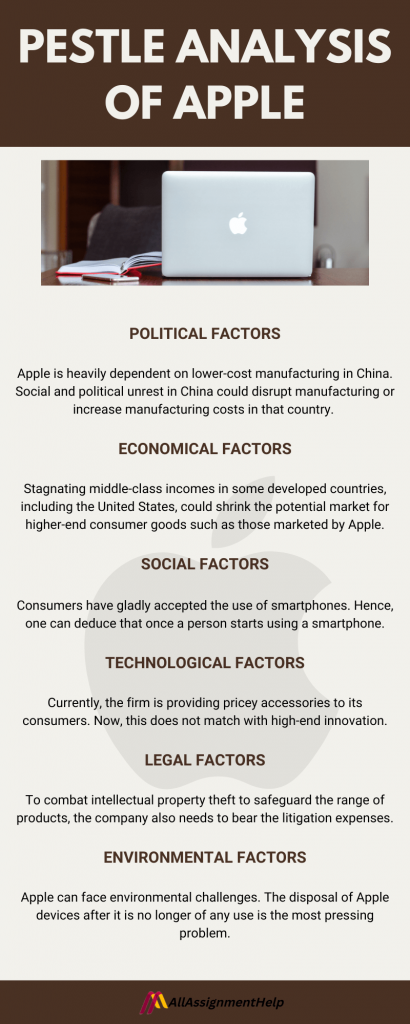
Political Factor: Improving Free Trade Policies
- Apple manufactures its products in China because of the lower cost of manufacturing charges. Hence, any political rift between the US and China may affect its operations. But, finding an alternative is not easy as it is expensive.
- You can also not deny that the company is in the dominant position. It is able enough to deal with some political pressure.
Economic Factor: Rapid Growth of Developing Countries
Apple must consider that an increase in labor costs in China could raise its manufacturing expenses. Additionally, a decline in middle-class incomes may negatively impact Apple’s market share. If the US dollar appreciates, exchange rates will rise, which could benefit Apple by enhancing its profit margins in China and Europe.
Social Factor: Rising Use of Mobile Access
- Although Apple is popular around the world, it still has not tasted success in areas like Africa. In the US, low-income people are against it as it is expensive. So, the appeal Apple is not much in China due to ethical concerns.
- Apple needs to make people aware of its features.
Technological Factor: Growing Cloud Computing Demand
- Google and Samsung have copied some of the features of Apple products and services. Some of the apps and services are also on the market, which shows that Apple is no different.
- So, increasing the use of smartphones and tablets may also decrease the demand for Apple products. In the high-tech surroundings, an Apple device may seem less secure. So, Apple needs to consider all these aspects when it comes to technology.
Legal Factor: Increasing Privacy Regulations
- Recently, Apple has started a highly regulated service through Apple Pay.
- Apple may have to face some regulations as a result. The government may also increase oversight of it.
- According to some reports, Apple may start automobile manufacturing. It may increase insurance, regulatory costs, and legal proceedings for Apple.
Environmental Factor: Energy Efficiency Trend
- The disposal of nonworking electronic devices is the biggest environmental issue for Apple. The disposal of lithium batteries is costly.
- China is very concerned about the environment and pollution. China has announced that it will limit the use of fossil fuels and greenhouse gases. It will increase the electricity cost. So, the manufacturing costs will increase for Apple as a result.
Also Read: Detailed PESTLE Analysis of Apple Computers
Conclusion
In conclusion, it is a must for Apple to look into all the matters that we discussed in the PESTLE analysis of it. However, this company is strong enough to keep doing well despite this challenge.
Also Read: How to Create the Best Business Startup Plan
Final Words
So, that sums up this article, where we explored the PESTLE analysis of five different companies. We hope these sample analyses were informative and valuable to you. If you need assistance with your business assignments, don’t hesitate to seek our business management assignment help. Additionally, we offer support for students facing problems with their online classes. Simply tell our experts, take my online class for me, and you’ll receive help from industry professionals ready to assist you.
FAQs
Q: Who is the father of PESTEL analysis?
A: Francis Aguilar, an American researcher with a focus on strategic planning, developed the PESTLE analysis more than fifty years ago. The now-known PESTLE tool was initially discovered in Aguilar’s book Scanning the Business Environment, which was released in the late 1960s.
Q: What Benefits Can be obtained from a PESTEL Analysis?
A: i) It may offer early notice of potential dangers and possibilities.
ii) Organizations can learn about external trends with the use of analysis.
iii) It urges companies to take into account their operating environment.
Q: How is PESTEL Analysis associated with marketing strategy planning?
A: A PESTLE analysis is a useful method for creating marketing strategies. This is so because marketing requires interaction with a world outside of your company. It can assist you in determining your target markets, the most effective marketing avenues, the ideal message timing, and conversion objectives.
